Class 8 History Chapter 2 Notes - From Trade to Territory
| Table of contents |

|
| Overview |

|
| East India Company Comes East |

|
| Company Rule Expands |

|
| Setting up a New Administration |

|
| Conclusion |

|
| Important Dates |

|
| Frequently Asked Questions |

|
Overview
The last powerful Mughal ruler was Aurangzeb and after his death in 1707, many Mughal governors (subadars) and big zamindars began asserting their authority and establishing regional kingdoms.
- By the second half of the eighteenth century, Britishers who originally came to India as traders started to emerge as a new power on the political horizon.
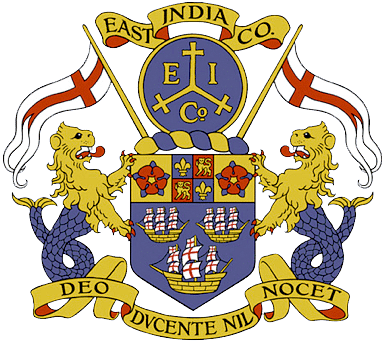 Logo of British East India Company
Logo of British East India Company
East India Company Comes East
In 1600 Royal Charter granted to East India Company granted the sole right to trade with the East. The company could explore new lands, procure goods at low prices, and sell them in Europe for higher profits without worrying about competition from other English trading groups.
 Routes to India in the 18th Century
Routes to India in the 18th Century
European Competition in Eastern Markets:
- Despite the royal charter, other European powers, such as the Portuguese, Dutch, and French, had already established themselves in Eastern markets when English ships began arriving.
- These traders were competing for valuable goods like cotton, silk, pepper, cloves, cardamom, and cinnamon.
Impact of Competition on Trade
- Competition among European trading companies caused prices to rise, reducing potential profits and leading to fierce battles, blockades, and conflicts for control of trade routes and markets.
Militarization of Trade and Local Conflicts
- Trading companies began using military tactics such as sinking ships, blockading routes, and fortifying trading posts.
- These actions often led to conflicts with local rulers and merged trade interests with political influence.
East India Company begins Trade in Bengal
In 1651, the first English factory was set up on the banks of river Hugli.
- Establishment of the First English Factory in Bengal: In 1651, the first English factory was set up on the banks of the river Hugli. It served as the base for the Company's traders, known as "factors" at that time. The factory included a warehouse for storing export goods and offices for Company officials.
 Aurangzeb
Aurangzeb
- Growth of Trade and Settlement: As trade expanded, the Company attracted merchants and traders to settle around the factory. By 1696, construction of a fort around the settlement began to protect the growing community.
- Acquisition of Zamindari Rights: In 1698, the Company acquired zamindari rights over three villages, including Kalikata, which later became Calcutta (Kolkata), through bribes. This acquisition strengthened the Company's control over the region.
- Aurangzeb's Farman and Duty-Free Trade: The Mughal emperor Aurangzeb granted a farman allowing the Company to trade duty-free, giving it significant advantages in Bengal.
- Manipulation of Trade Privileges: The Company sought additional privileges, manipulating existing ones, which led to revenue losses for Bengal. Although the Company had exclusive duty-free trading rights, its officials engaged in private trade without paying duties, causing financial harm to Bengal.
- Nawab of Bengal's Struggles: The Nawab of Bengal, Murshid Quli Khan, faced difficulties in addressing the revenue losses caused by the Company's abuse of trade privileges.
How Trade Led to Battles
The conflict between the Company and the nawabs of Bengal intensified.
- Strong Leadership of the Bengal Nawabs: The nawabs—Murshid Quli Khan, Alivardi Khan, and Sirajuddaulah—resisted the Company's growing influence and demands.
- Nawab's Opposition to Company Concessions: The nawabs denied further concessions to the Company, demanded heavy tributes, and imposed restrictions on its activities.
- Accusations Against the Company: The Company faced allegations of tax evasion, disrespectful conduct, and undermining the Nawab's authority.
- Company's Justification for Expanding Trade: The Company argued that unjust demands by the nawabs hindered trade and advocated for the removal of duties to encourage commerce.
- Expansion of Company's Settlements and Fortifications: The Company aimed to expand its trade by enhancing its settlements, acquiring more villages, and strengthening forts.
- The Road to the Battle of Plassey: The escalating conflicts between the Company and the nawabs eventually led to the significant Battle of Plassey.
The Battle of Plassey
Alivardi Khan's death in 1756 led to Sirajuddaulah becoming the Nawab of Bengal.
- The Company's Aim for Control: The East India Company sought a puppet ruler who would grant trade concessions and support its interests.
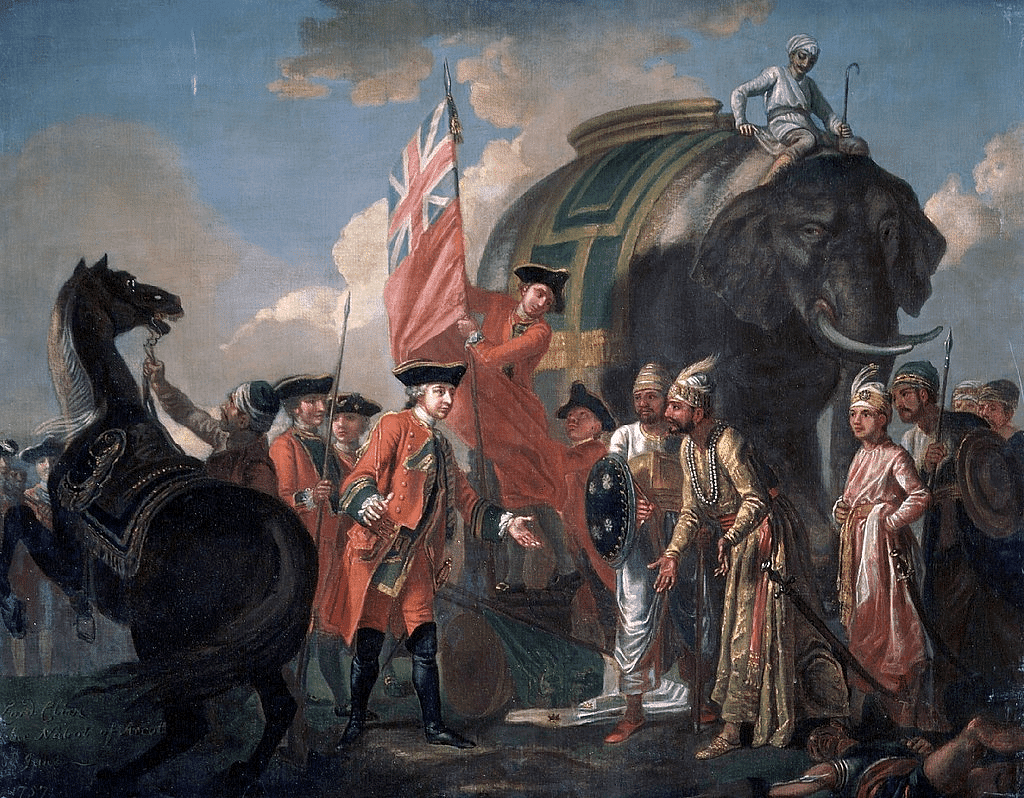 An oil-on-canvas painting depicting the meeting of Mir Jafar and Robert Clive after the Battle of Plassey
An oil-on-canvas painting depicting the meeting of Mir Jafar and Robert Clive after the Battle of Plassey
- Sirajuddaulah's Resistance: Sirajuddaulah, angered by the Company's interference, captured English officials and blockaded their operations.
- Robert Clive's Victory at Plassey: In 1757, Robert Clive led Company forces against Sirajuddaulah at the Battle of Plassey, securing a decisive victory.
- Mir Jafar's Betrayal: Mir Jafar's betrayal of Sirajuddaulah was instrumental in the Nawab's defeat at Plassey.
- Impact of the Battle of Plassey: The Battle of Plassey marked a significant turning point for the East India Company in India, consolidating its power.
- Rise and Fall of Puppet Nawabs: After Plassey, Mir Jafar became Nawab, but the Company remained focused on trade expansion, leading to challenges with puppet rulers. Mir Qasim replaced Mir Jafar but was eventually defeated by the Company at the Battle of Buxar in 1764.
- Company's Financial Motives: The East India Company sought more revenue to fund wars and meet trade demands, leading to a shift towards direct administration.
- Diwani Rights and Revenue Control: In 1765, the Mughal emperor appointed the Company as the Diwan of Bengal, granting it access to Bengal's revenue resources.
- Bengal's Revenue as a Financial Base: The Company's access to Bengal's revenue allowed it to reduce reliance on imports from Britain and finance textile purchases, maintain troops, and cover infrastructure costs in India.
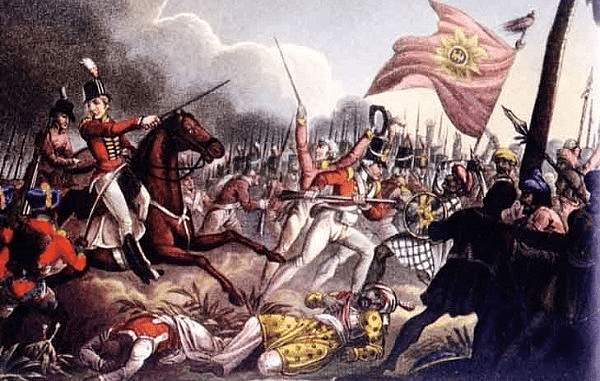 Battle of Buxar, 1764: The Defining Battle of India
Battle of Buxar, 1764: The Defining Battle of India
Company officials become “nabobs”
Company officials transformed into "nabobs," aspiring to live like nawabs, gaining power and authority.
- Post-Plassey Wealth and Power: After the Battle of Plassey, Bengal's nawabs were compelled to offer land and significant wealth to Company representatives.
- Robert Clive's Fortune and Controversy: Robert Clive, arriving in Madras from England at 18, amassed a fortune in India, worth €401,102 upon departing in 1767. Despite being urged to eliminate corruption in the Company's administration upon his appointment as Governor of Bengal in 1764, Clive faced suspicion regarding his wealth from the British Parliament in 1772. Although acquitted, Clive committed suicide in 1774.
- Challenges Faced by Other Officials: While not all Company officials emulated Clive's success, many faced early demise due to disease and conflict. It is unfair to label all officials as corrupt; several hailed from modest backgrounds, aiming to earn adequately in India, then lead a comfortable life in Britain.
- Lifestyle and Perception of Returning Officials: Returning officials who acquired wealth lived extravagantly, displaying their riches, and were dubbed as "nabobs," a term derived from the Indian word nawab. These individuals, often viewed as social climbers and upstarts in British society, were subjects of ridicule and satire in various forms of entertainment.
Company Rule Expands
After analysing the process of annexation of Indian states by the East India Company from 1757 to 1857, certain key aspects emerge.
- Methods of Expansion: The Company rarely used direct military attacks, preferring political, economic, and diplomatic methods to extend its influence before annexing Indian territories.
- Administrative Measures: After the Battle of Buxar, the Company appointed Residents in Indian states as political or commercial agents to advance its interests.
- Subsidiary Alliance System: The subsidiary alliance system prohibited Indian rulers from maintaining independent armed forces, requiring them to pay for the Company's "subsidiary forces" for protection, with penalties for non-compliance.
Tipu Sultan- ‘The Tiger of Mysore’
The British East India Company engaged in direct military conflict with Mysore when its political or economic interests were at risk. Mysore, under leaders like Haidar Ali and Tipu Sultan, controlled trade on the Malabar coast, a crucial source of pepper and cardamom for the Company.
 Tipu Sultan: Tiger of Mysore
Tipu Sultan: Tiger of Mysore
- Disruption of Trade: In 1785, Tipu Sultan disrupted trade by halting key exports and preventing local merchants from trading with the Company. He also formed an alliance with the French and modernized his army.
- Wars and Defeat: The British viewed Haidar and Tipu as ambitious threats, leading to a series of wars culminating in the Battle of Seringapatam in 1799, where Tipu Sultan was killed.
- Post-War Changes: After Tipu Sultan's death, Mysore was placed under the Wodeyar dynasty, and the British East India Company imposed a subsidiary alliance on the state.
War with the Marathas
The Company, from the late eighteenth century, aimed to dismantle Maratha power.
- Impact of the Third Battle of Panipat: The Marathas were defeated in the Third Battle of Panipat in 1761, shattering their hopes of ruling from Delhi.
- Division and Organization of Maratha States: The Marathas were divided into various states under different chiefs (sardars) from dynasties such as Sindhia, Holkar, Gaikwad, and Bhonsle, with a Peshwa serving as the effective military and administrative head in Pune.
- Series of Wars with the Marathas:
The First Anglo-Maratha War ended in 1782 with the Treaty of Salbai, with no clear victor.
The Second Anglo-Maratha War (1803-05) resulted in British gains including Orissa and territories north of the Yamuna river, including Agra and Delhi.
The Third Anglo-Maratha War (1817-19) ultimately crushed Maratha power.
The Claim to Paramountcy
Paramountcy a new policy was initiated under Lord Hastings (Governor General from 1813 to 1823). The Company claimed that its power was greater than that of Indian states.
- In the late 1830s, the East India Company became worried about Russia. It imagined that Russia might expand across Asia and enter India from the northwest.
- The Company fought a prolonged war with Afghanistan between 1838 and 1842 and established indirect Company rule there. Punjab was annexed in 1849, after two prolonged wars.
The Doctrine of Lapse
Under Lord Dalhousie who was the Governor-General from 1848 to 1856, the final wave of annexations occurred.
- The Doctrine of Lapse is a policy devised by him that declared that if an Indian ruler died without a male heir his kingdom would “lapse”, that is, become part of Company territory.
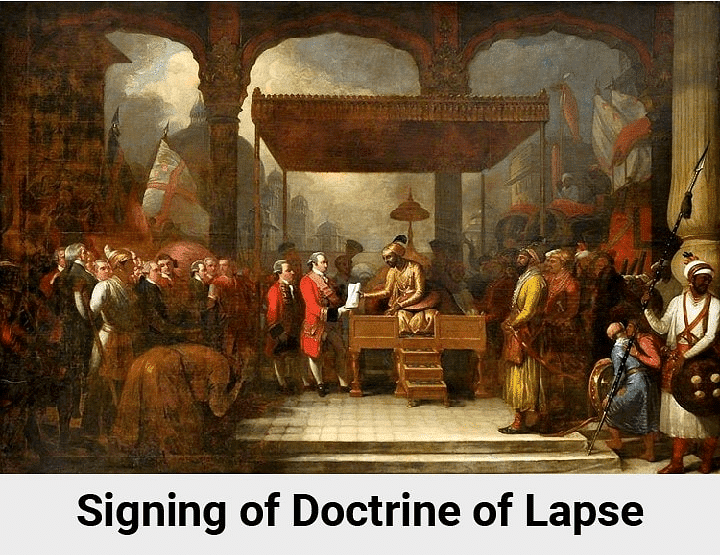
- In 1856, the Company took over Awadh. Enraged by the humiliating way in which the Nawab was deposed, the people of Awadh joined the great revolt that broke out in 1857.
Setting up a New Administration
Warren Hastings (Governor-General from 1773 to 1785) played a significant role in the expansion of Company power. During his time, the Company had acquired power in Bengal, Bombay, and Madras.
- British territories were broadly divided into administrative units called Presidencies. There were three Presidencies: Bengal, Madras, and Bombay.
- Each was ruled by a Governor. In 1772 a new system of justice was established. According to the new system, each district needed to have two courts: a criminal court ( faujdari adalat ) and a civil court (diwani adalat).
- The Brahman pandits have different interpretations of local laws based on different schools of the Dharmashastra.
- To bring uniformity, in 1775 eleven pandits were asked to compile a digest of Hindu laws. By 1778 a code of Muslim laws was also compiled for the benefit of European judges.
- Under the Regulating Act of 1773, a new Supreme Court was established, while a court of appeal – the Sadar Nizamat Adalat – was also set up at Calcutta.
- The Collector was the principal figure in an Indian district. His job was to collect revenue and taxes and maintain law and order in his district with the help of judges, police officers, and darogas.
The Company Army
- In India, colonial rule brought some new ideas of administration and reform. The Mughal army was composed of cavalry (sawars: trained soldiers on horseback) and infantry, that is, paidal (foot) soldiers.
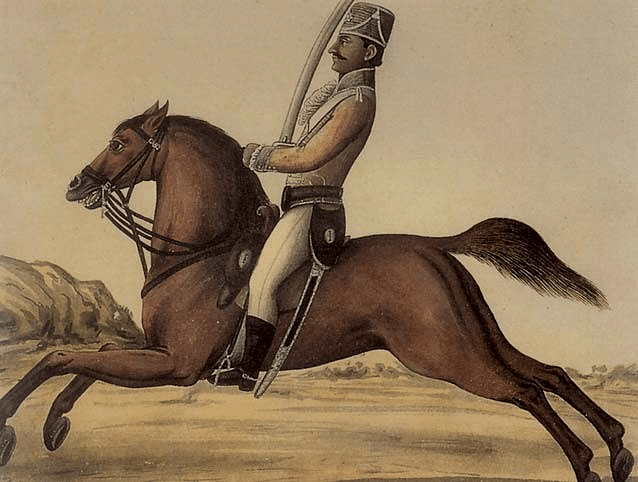 A Sarwar of Bengal in the service of the company.
A Sarwar of Bengal in the service of the company.
- The army of the Mughals was dominated by cavalry. In the eighteenth century, changes occurred when Mughal successor states like Awadh and Benaras started recruiting peasants into their armies and training them as professional soldiers.
- The East India Company adopted the same method which came to be known as the sepoy army (from the Indian word sipahi, meaning soldier).
- In the early nineteenth century, the British began to develop a uniform military culture. Soldiers were subjected to European-style training, drills, and discipline that regulated their lives far more than before.
Conclusion
- The East India Company was transformed from a trading company to a territorial colonial power.
- In the early nineteenth century, new steam technology arrived.
- By 1857 the Company came to exercise direct rule over about 63 percent of the territory and 78 percent of the population of the Indian subcontinent.
Important Dates
- 1498: Vasco da Gama discovered the sea route to India
- 1600: the East India Company acquired a charter from the ruler of England Queen Elizabeth 1 granting it the sole right to trade with the East.
- 1651: the first English factory was set up on the banks of the river Hugli
- 1743: Robert Clive came to India from England
- 1756: alivardi Khan died and shujaUddaula became the emperor of Bengal
- 1750 2nd: the Battle of Plassey was fought between SirajUddaulah and the English East India Company (to be precise Robert Clive)
- 1764: the Battle of Buxar was fought between Qasim and the British East India Company
- 1764: Robert Clive was appointed as the governor of Bengal
- 1765: Mir Jafar died
- 1765: the Mughal emperor appointed the company as the Diwan of the provinces of Bengal
- 1767: Robert Clive left India
- 1773 to 1785: Warren Hastings was the governor general
- 1772: a new system of justice was established by Warren Hastings
- Regulation Act of 1773: by this act a new Supreme Court was established in Calcutta
- 1774: Robert Clive committed suicide
- 1761- 1782: Hira of Hyder A1785: Tipu Sultan stopped the export of Sandalwood paper and cardamom through the ports of his Kingdom
- 1767-69,1780-84,1790-92,1799: 4 Anglo-Mysore wars were fought
- 1782-99: era of Tipu Sultan
- 1782: Treaty of salbai
- 1798-1805: the era of Richard Wellesley as governor-general
- 4th May 1799: Tipu Sultan died defending his capital seringapatnam
- 1813- 1823: the era of Lord Hastings as governor-general
- 1817: James Mill, a Scottish economic and political philosopher published a massive three-volume work named The History of British India
- 1824: Rani Channamma two arms and LED and anti-British resistance movement was arrested in 1824 and later was killed in 1829
- 1834: slavery was ended in South Africa
- The period between 1838 and 1842: war with Afghanistan was fought by the British East Indian Company
- 1839: Ranjit Singh died
- 1843: British captured Sindh
- 1849: Punjab was annexed by the British
- 1848 to 1856: Lord Dalhousie was the governor-general
- 1848: Satara was annexed using the doctrine of lapse
- 1850: Sambalpur was annexed using the doctrine of lapse
- 1853: Nagpur was annexed using the doctrine of lapse
- 1854: Jhansi was captured using the doctrine of lapse
- 1856: Avadh was captured by the British
Frequently Asked Questions
Q.1. Write a short note on Tipu Sultan.
Ans: Tipu Sultan was the son of Haidar Ali, ruler of Mysore. He was known as the “Tiger of Mysore”. He ruled Mysore from 1782 to 1799. Four wars were fought between the British and Mysore and were known as the Anglo-Mysore wars(1767-1769, 1780-84, 1790-92and 1799). In 1799, the Britishers won the battle of Seringapatam against Mysore where Tipu Sultan was killed.
Q.2. What was the Doctrine of Lapse? Which kingdoms did the Company annexe by applying this Doctrine?
Ans: The Doctrine of Lapse was the culmination of the Company’s territorial expansion policy. It was implemented by Lord Dalhousie, the Governor-General of India from 1848 to 1856. According to the doctrine if an Indian ruler died without a male heir his kingdom would ‘lapse’, that is, become a part of Company territory. Several kingdoms were annexed by applying this doctrine - Satara, Sambalpur, Udaipur, Nagpur, Jhansi, and Awadh.
|
65 videos|424 docs|46 tests
|
FAQs on Class 8 History Chapter 2 Notes - From Trade to Territory
| 1. What was the role of the East India Company in India during the 18th century? |  |
| 2. How did the East India Company set up its administration in India? |  |
| 3. What were the major events that led to the expansion of Company rule in India? |  |
| 4. What impact did the East India Company's rule have on Indian society and economy? |  |
| 5. When did the East India Company officially end its rule in India? |  |



















